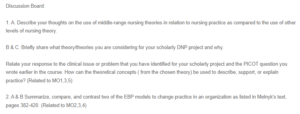Middle-range Nursing Theories in Psychiatric Care
Nursing theories are the backbone of nursing practice. They help nurses incorporate and articulate evidence from research that justifies aspects of nursing practice (Younas & Quennell, 2019). Middle-range nursing theories encompass ideas focused on a narrower dimension of nursing practice. These theories provide better connections between theoretical nursing knowledge and conventional practice. They are also less abstract compared to grand theories and thus readily applied or incorporated into practice. Roy (2021) also reports that these theories are testable through research and, therefore, verifiable. This makes them superior to grand theories.
Since my project is centered on psychiatric care, middle-range theories that may be applicable include the theory of cultural marginality and the theory of uncertainty of illness. The theory of cultural marginality seeks to enhance nurses’ recognition of distinct cultures and the unique experiences of clients from different cultures. With increasing acculturation and diversity in healthcare, understanding these unique experiences may help nurses identify factors that interplay in the development of mental health illnesses across individuals. Further, the theory of uncertainty of illnesses maintains applicability due to the chronic nature of psychiatric presentations and their potential to recur if not managed properly.
The John Hopkins Model of Evidence-Based Practice (JHMEBP) and the Iowa Model of Evidence-Based Practice (IMEBP) are examples of EBP models that can be used to change organizational practice. Both models provide an in-depth way of scrutinizing evidence to be incorporated into practice. Additionally, these models are centered on the fundamentals of clinical practice, patient values and preferences, and the use of research findings. JHMEBP, however, offers a broad and more comprehensive framework for incorporating EBP. It is also a complex, multi-stepped model with several differentiating factors (Liza Anicoche & Kaiser, 2021). The Iowa model, on the other hand, is more quality-oriented (Chiwaula et al., 2021). It also provides point-to-point steps that are not further separated from the main framework.
References
Chiwaula, C. H., Kanjakaya, P., Chipeta, D., Chikatipwa, A., Kalimbuka, T., Zyambo, L., Nkata, S., & Jere, D. L. (2021). Introducing evidence-based practice in nursing care delivery, utilizing the Iowa model in the Intensive Care Unit at Kamuzu Central Hospital, Malawi. International Journal of Africa Nursing Sciences, 14, 100272. https://doi.org/10.1016/j.ijans.2020.100272
Liza Anicoche, P. I., & Kaiser, C.-I. L. (2021). The Johns Hopkins Evidence-based practice (EBP) model: Weinberg perianesthesia interventions for a healing environment. Journal of PeriAnesthesia Nursing, 36(4). https://doi.org/10.1016/j.jopan.2021.06.064
Roy, C. (2021). The nursing theory makes a practice turn in the 21st Century. Aquichan, 21(4), 1–11. https://doi.org/10.5294/aqui.2021.21.4.2
Younas, A., & Quennell, S. (2019). The usefulness of nursing theory‐guided practice: An integrative review. Scandinavian Journal of Caring Sciences, 33(3), 540–555. https://doi.org/10.1111/scs.12670
ORDER A PLAGIARISM-FREE PAPER HERE
We’ll write everything from scratch
Question

Middle-range Nursing Theories in Psychiatric Care
Discussion Board:
1. A. Describe your thoughts on the use of middle-range nursing theories in relation to nursing practice as compared to the use of other levels of nursing theory.
B & C. Briefly share what theory/theories you are considering for your scholarly DNP project and why.
Relate your response to the clinical issue or problem that you have identified for your scholarly project and the PICOT question you wrote earlier in the course. How can the theoretical concepts ( from the chosen theory) be used to describe, support, or explain practice? (Related to MO1,3,5)
2. A & B Summarize, compare, and contrast two of the EBP models to change practice in an organization as listed in Melnyk’s text, pages 382-420. (Related to MO2,3,4)


